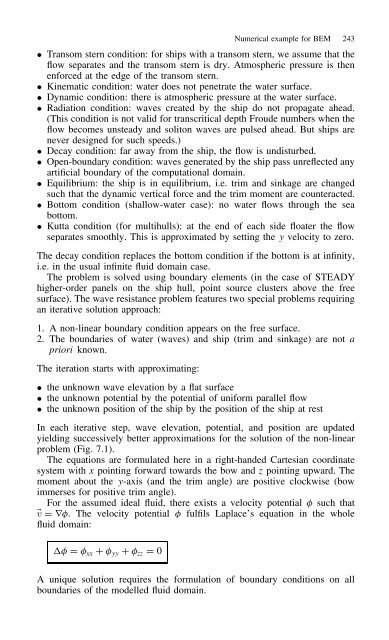Practical Ship Hydrodynamics
Practical Ship Hydrodynamics
Practical Ship Hydrodynamics
You also want an ePaper? Increase the reach of your titles
YUMPU automatically turns print PDFs into web optimized ePapers that Google loves.
Numerical example for BEM 243<br />
ž Transom stern condition: for ships with a transom stern, we assume that the<br />
flow separates and the transom stern is dry. Atmospheric pressure is then<br />
enforced at the edge of the transom stern.<br />
ž Kinematic condition: water does not penetrate the water surface.<br />
ž Dynamic condition: there is atmospheric pressure at the water surface.<br />
ž Radiation condition: waves created by the ship do not propagate ahead.<br />
(This condition is not valid for transcritical depth Froude numbers when the<br />
flow becomes unsteady and soliton waves are pulsed ahead. But ships are<br />
never designed for such speeds.)<br />
ž Decay condition: far away from the ship, the flow is undisturbed.<br />
ž Open-boundary condition: waves generated by the ship pass unreflected any<br />
artificial boundary of the computational domain.<br />
ž Equilibrium: the ship is in equilibrium, i.e. trim and sinkage are changed<br />
such that the dynamic vertical force and the trim moment are counteracted.<br />
ž Bottom condition (shallow-water case): no water flows through the sea<br />
bottom.<br />
ž Kutta condition (for multihulls): at the end of each side floater the flow<br />
separates smoothly. This is approximated by setting the y velocity to zero.<br />
The decay condition replaces the bottom condition if the bottom is at infinity,<br />
i.e. in the usual infinite fluid domain case.<br />
The problem is solved using boundary elements (in the case of STEADY<br />
higher-order panels on the ship hull, point source clusters above the free<br />
surface). The wave resistance problem features two special problems requiring<br />
an iterative solution approach:<br />
1. A non-linear boundary condition appears on the free surface.<br />
2. The boundaries of water (waves) and ship (trim and sinkage) are not a<br />
priori known.<br />
The iteration starts with approximating:<br />
ž the unknown wave elevation by a flat surface<br />
ž the unknown potential by the potential of uniform parallel flow<br />
ž the unknown position of the ship by the position of the ship at rest<br />
In each iterative step, wave elevation, potential, and position are updated<br />
yielding successively better approximations for the solution of the non-linear<br />
problem (Fig. 7.1).<br />
The equations are formulated here in a right-handed Cartesian coordinate<br />
system with x pointing forward towards the bow and z pointing upward. The<br />
moment about the y-axis (and the trim angle) are positive clockwise (bow<br />
immerses for positive trim angle).<br />
For the assumed ideal fluid, there exists a velocity potential such that<br />
Ev Dr . The velocity potential fulfils Laplace’s equation in the whole<br />
fluid domain:<br />
1 D xx C yy C zz D 0<br />
A unique solution requires the formulation of boundary conditions on all<br />
boundaries of the modelled fluid domain.
















